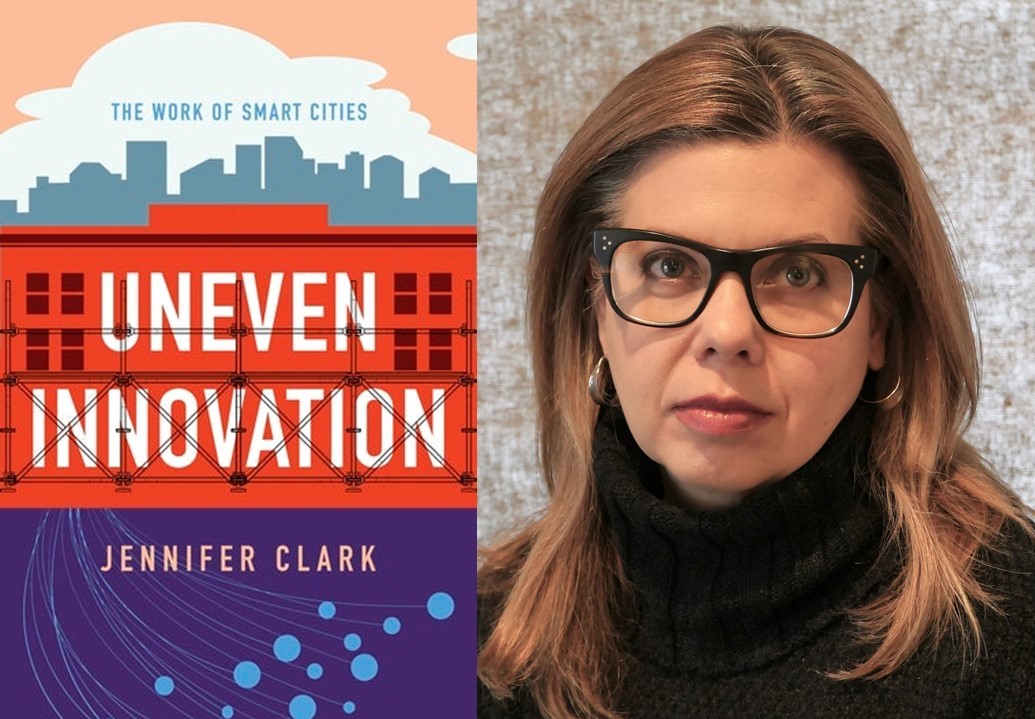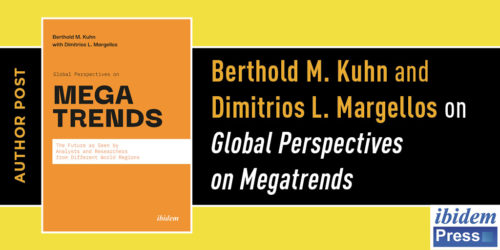Jennifer Clark on the Paths Toward Smart Cities

“A superb, original, and informative intervention into ongoing debates about what a smart city is and its implications across all cities. Grounded in significant original and secondary research, Clark links smart cities to urban innovation and the production of markets, crucially arguing that the smart city is an economic rather than technological issue.”
~Robyn Dowling, University of Sydney
The future is increasingly driven by technology, but can technology stop uneven development patterns in the smart cities project? That’s one of the many solutions that Jennifer Clark, author of Uneven Innovation: The Work of Smart Cities, discusses in today’s post about creating a smart city built on equality.
If you enjoy this post, make sure to enter our giveaway for a chance to win a copy of Uneven Innovation.
• • • • • •
Recently a German artist, Simon Weckert, managed to confuse Google Maps into reporting a traffic jam simply by dragging a little red wagon with 99 cell phones slowly through the streets of Berlin. Such examples underscore how limited the technologies behind smart cities really are. In spite of claims to the contrary, the twenty-first century version of this vision of an advanced urban operating system is partial, incomplete, and fundamentally uneven.
“In spite of claims to the contrary, the twenty-first century version of this vision of an advanced urban operating system is partial, incomplete, and fundamentally uneven.”
I was motivated to write the book because the incomplete implementation of the smart cities project was increasingly cast as a technology problem rather than a policy problem. I wanted to highlight and pursue an emerging critique of the technology sector that promotes inequalities rather than mitigates them. My critique aligns with exposés about Silicon Valley’s discriminatory human resources practices are only outnumbered by stories of predatory business practices. In Uneven Innovation, I note that economic geographers have long argued that firm strategies reflect the places and industries from which the firms themselves emerged. So, as technology firms turn their attention to cities, it should be understood that they are likely to employ the approaches and practices they know from the past rather than adapt to the ethics and standards of the public sector or the norms and established practices of individual communities.
The book is in many ways a reminder that we should expect what we are getting in the smart cities project —a private sector approach to public services. My research on smart cities led me to question several assumptions behind the urban innovation project—both what it means for cities and what it does to them. The result is an alternative framework for thinking about smart cities as an economic development project with implications for labor and work, participation and engagement, infrastructure and real estate investment, interjurisdictional cooperation and competition, and the relationship between public and private interests. This framework is captured in five key premises about how, under the novelty of the smart cities project, we must ask the same core questions about the private development of public assets; namely, cities.
“As technology firms turn their attention to cities, it should be understood that they are likely to employ the approaches and practices they know from the past rather than adapt to the ethics and standards of the public sector or the norms and established practices of individual communities.”
The first premise of the book is that uneven innovation is both where we’ve been and where we are going; this is not a new path. The second premise is that the tech sector needs the city as a source of subsidy and risk reduction; it exploits uneven innovation and maintains it. Third, the smart cities project is enabled through “fast policy,” a combination of devolution and policy mobilities which circumvents traditional models of policy transfer (Peck and Theodore 2015). The fourth premise underscores the subtitle of the book: work. The smart cities project exacerbates and amplifies precarious work, embedding labor flexibility in the production and operations of the built environment. And finally, the fifth premise of the book is that the data is the product of the smart cities project and the revenue model remains under construction.
In reality, there are many possible paths toward the promise of smart cities, and some of them align with community economic development practice and public participation. However, other paths replicate a pattern of development and redevelopment reminiscent of those practices that brought about the backlash against urban renewal in the first place. That is, projects that are too big, too fast, and too uneven and that give far too little thought to the existing built environment and the people who live in it and, simultaneously, too much consideration for the so-called revenue potential of places and what can be extracted from them.
In Uneven Innovation I pose the question of whether it is possible to construct a smart cities project that stops reproducing uneven development patterns through technology solutions. “Uneven innovation” describes a manifestation of an old problem: the sexist city, the racist city, the classist city, the city of unequal opportunities and inequitable outcomes. That said, there are two further points to be made.
“Technological adaptation is a feature in urban policy and planning; it is not new. It actually happens every day through individual choices and institutional decisions.”
First, cities themselves are not the problem, and, second, cities may, in fact, be the solution. Once the technology sector determined that cities were their preferred space of innovation, production, and consumption, cities gained the ability to manage and (to some extent) determine the smart cities project. Through the regulation of citizen rights to data, investments in the internal capacity within cities, the undertaking of strategic planning and policy analysis and evaluation, and the expansion of participatory planning, cities have an opportunity to shape rather than simply accept the smart cities project.
Implementation of the smart cities project as described in the popular press is an incremental process that is cast as a disruptive intervention. It will take time, and in that time, there is the opportunity to reflect on how cities and citizens can shape the smart cities project and how urban policy can respond to the technology experiments that are redrawing the boundaries between public and private interests and ownership. Technological adaptation is a feature in urban policy and planning; it is not new. It actually happens every day through individual choices and institutional decisions.
Patterns of technology diffusion and industry change are often responses to emerging markets as well as the introduction of new materials, processes, or products that enable increased productivity, sustainability, or profitability, depending on the goals of the producer. In other words, new technologies enable optimization—in terms of efficiency or quality. But this optimization is predicated on the ability of institutions or firms to absorb new technologies, not simply to invent them. The growing role of cities in providing a platform for innovation creates new opportunities for firms but also for cities themselves.
“The smart cities project provides a platform for economic development; it is not economic development by itself. And perhaps this is a key distinction moving forward.”
For example, the expanding availability of public data enables civic and social innovators to develop new services or products, including software, sensors, and data and service subscriptions; to develop new processes for performance optimization to provision existing public services more efficiently; and to upgrade infrastructure and urban design investments to contribute to either new data or enhanced performance, or both. In other words, a possible outcome of investments in the smart cities platform is an agenda driven by civic innovation rather than one set through industry interests. The platform, like the city itself, can serve a social, political, and economic purpose.
In many ways, then, smart cities are a new approach to an old question: how to remake cities for the purposes of further and continued economic development with the functional consent (if not the real support) of the people who actually live there. In analyzing the smart cities project, then, it is essential to sort out what is new or novel about this urban development strategy—what is actually innovative about either the processes producing smart cities or the products and services deployed in smart cities.
The smart cities project provides a platform for economic development; it is not economic development by itself. And perhaps this is a key distinction moving forward. As cities and observers of the smart cities project become increasingly cognizant of the inequalities that are produced and magnified in the diffusion of new technologies, it may be the responsibility of the public sector to step up and intervene, not step back and allow the people and places to be cast as users and testbeds in an industry experiment rather than as citizens and communities in a real place, the city.








